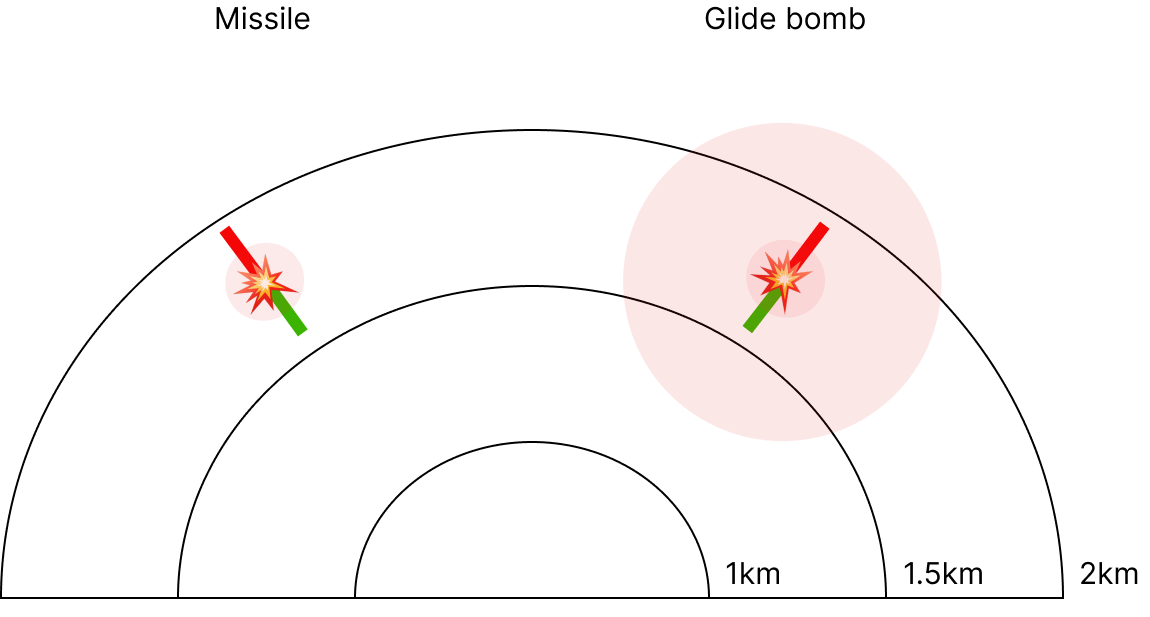Radian shield - Drone-based glide bomb defense
Warfare - Part IX
Ukraine needs the ability to arrest incoming glide bombs in order to preserve life and stabilize the front.
In this post I will outline a drone-based defense system reliant on drone-teams and explosive nets.
It’s built on the following key insights:
Glide bomb blast radius is relatively modest
The largest blast radius of a FAB-3000 is around 900 meters which means that a defense system that can reliably blow up the incoming bomb 1km in the air can effectively neutralize it with limited collateral damage.
The closer an inbound projectile gets, the smaller the circle becomes of its potential strike point.
Think about it when you eat an ice cream cone, the circle of the remaining cone gets smaller and smaller the more you eat of the ice cream.
In effect, the diameter of the cone is narrowing over time.
Intercepting the inbound bomb with another projectile however is not ideal because the same effect applies to an interceptor missile. Ideally the interceptor plane doesn’t narrow or even better it could even increase.
Projectile-based interception has too many contingencies
With a kinetic hit, you need to make sure your missile is exactly at the very tip of the cone to intercept but any error in the calculation of the trajectory might result in your (very expensive) missile to miss the interception point.
Taking into account that glide bombs change trajectory towards their target this makes it difficult to get right.
An interceptor that remains at the same height or even descend is much easier.
The defender has the radian advantage
The green arrow is the arc length that a drone system would have to relocate to intercept the incoming missile.
The drone has to travel a much shorter distance than the incoming bomb which is why a slower moving drone would still have time to move into position.
Intuitively you can see that one drone can defend a certain area of the circle (‘sector’) and this sector depends on the detection range, the drone speed and the altitude of the drone.
Explosive nets can be carried by drones
Another way to increase the probability of interception is to not intercept at the 'tip of the cone’ but rather intercept an area.
Nets are cheap and are light enough to be carried by drones to a high altitude.
The nets should be laced with explosives in order to trigger the secondary detonation inside the glide bomb.
There is a tradeoff of weight, size, amount of explosives and density of the net that has to be found through experimentation.
Dyneem or kevlar rope is shock resistant and light rope material that can be used for the net and the explosives could be any shock-sensitive explosive (e.g. TATP).
The net has to be strong enough to actually attach to the inbound glide bomb and not have the glide bomb fly straight through.
General rule for the net design is:
- lighter nets are better
- larger nets are better
- nets that explode faster are better
- tigher interconnections between the net is better (more likelihood of 'being dragged along by the missile)
- more shock resistant nets are better
If it proves unfeasible to catch the missile in a net then it can also be pre-detonated electrically just moments before impact.
Defense-in-depth can be used to increase success ratio
Depending on the availability of drones, the drones could operate on consecutive layers (e.g. first layer at 2km radius, second at 1.5km radius, third at 1km and final last-ditch at 500 meters).
The layers operating at higher altitude require more drones to cover but it’s worth doing as you get four chances to intercept the incoming bomb or potentially intercept 4 glide bombs in the same sector.
The number of layers can grow and shrink depending on available drones and importance of the target. (e.g. you probably want at least 5 layers around the Kyiv Sea Dam and your energy infrastructure).
Defense layers can be dynamically reconfigured after interceptions
This element is close to science-fiction where the sphere that can be adequately defended shrinks on each consecutive strike.
You can shrink the sphere to deal with drone net loss and you can grow the sphere by launching more drone nets.
"Repairing the shield" can be done by shifting the neighboring drone nets downwards while new drone nets are launched through the ascent cylinder.
Battery lifecycle management
Drones run out of battery (sadly) so they have to be rotated out.
In order to keep it efficient, drones should always start operating at the highest point and descend downwards.
Once below operational height they can fly back to base to have their batteries changed and other maintenance can be done.
The drone net could be relaunched in short order through the ascent cylinder to its designated operating radius.
In short, the drone shield can be managed highly efficiently from the location it’s meant to defend.
In addition, this system is completely mobile and can be integrated in fast-moving armored assaults.
Interception algorithm
It’s super simple, just fly the drone to the center of the inbound missile cone and try to keep it there.
You need an independent radar system of which Ukraine has received many (in fact, Poland could provide some radar coverage also).
You need to compute the inbound missile cone and instruct the drone net to race towards the center of that cone.
Can it scale to defend cities?
The math is probably a bit different with cities compared to critical sites as they can’t be defended by perfect spheres but you can connect them like soap bubbles.

It’s highly economical
Let’s assume four heavy lift drones can hold up a 7x7 square net and can fly 15 meters/second.
Assuming we can detect an inbound glide bomb at 5 km distance with the Robin Radar systems and the bomb flies at 150 km/hr.
It would have to be intercepted beyond the 1km range.
This means the bomb still has to fly 4km before hitting the interception path.
This gives us about 96 seconds before impact which we’ll round to 100 seconds for easier calculations.
Our drone net can travel 1500 meters along the radian.
The total circle to defend is 2*PI*R = 2*PI*1 km= 6.28 km.
However, the drone could travel in either direction along the circle so it’s covered radian is 3000 meters.
The angle a single drone net can cover is close to 180 degrees (3000/6280*360 degrees = 171 degrees)
A single drone net can defend a critical point against glide bombs when flying at 1km radius.
You need to add one drone for every 1km increase in radius and in practice, you will always want to fly multiple.
#drones = (4 * 1.0472 * height (km))^2
How much does it cost?
The components are:
Heavy lift drones (or many small lift drones) - ± 20000 usd (4 needed)
Net without explosives - ± 1000 usd
Explosives - ± 3000 usd
This means every interception costs 85k.
The system costs 190k to defend against glide bombs (2 drone nets)
The Radian shield could intercept glide bombs at $4k per interception.
Assuming the drones carrying the net remain alive that is.








